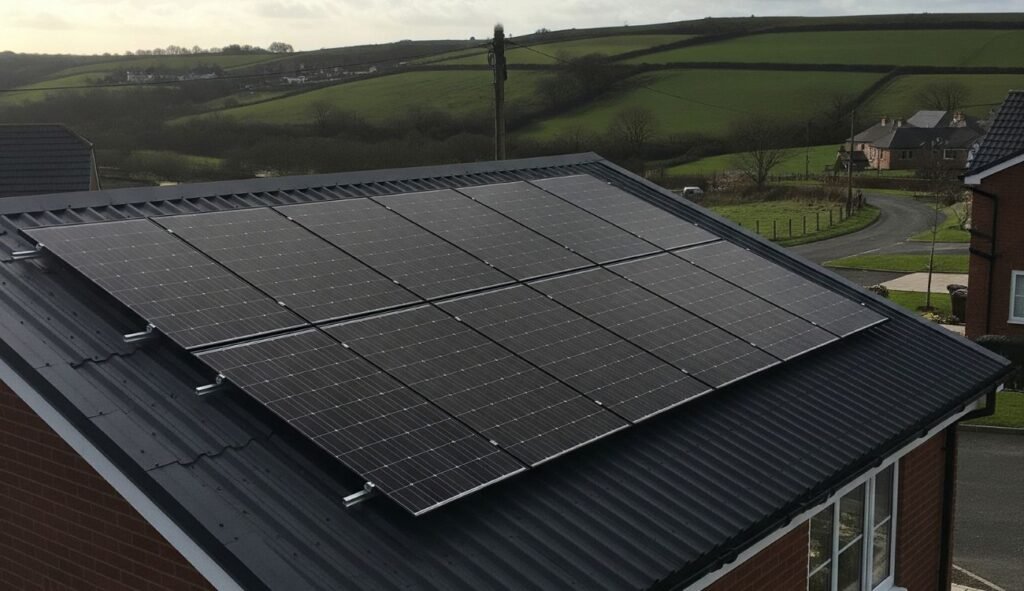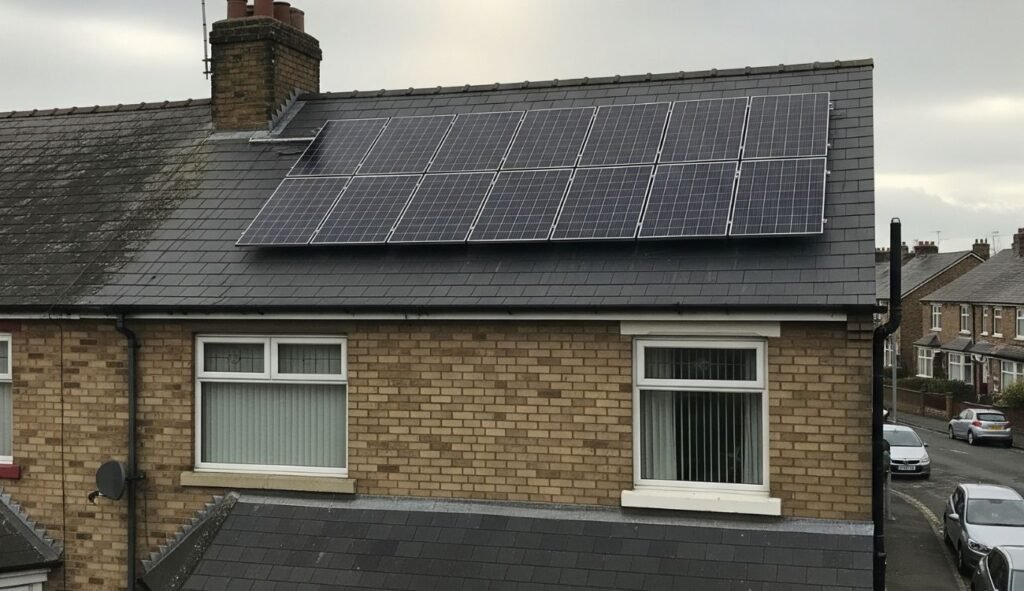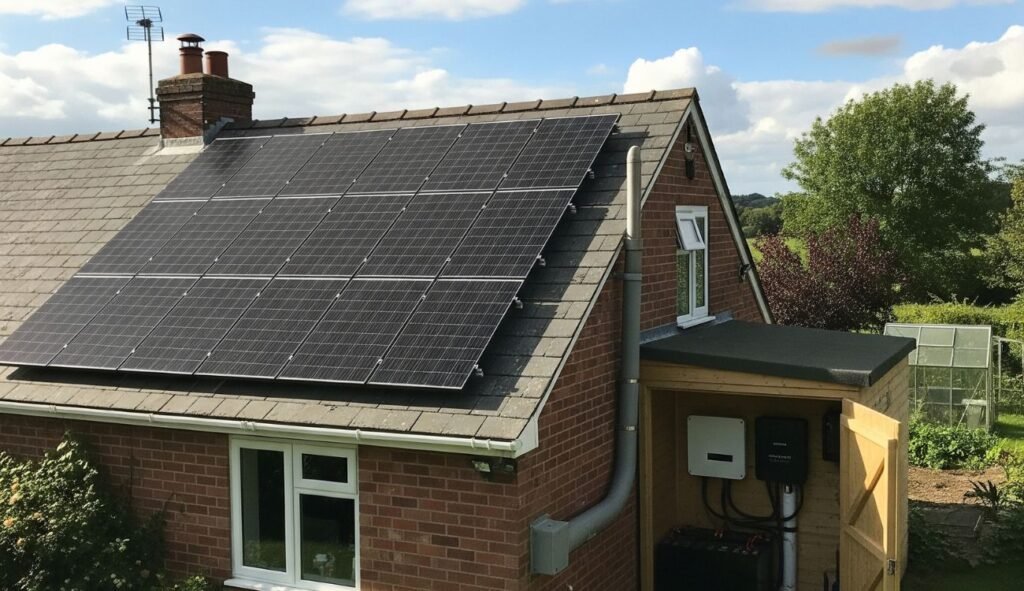Tile roofs are common across the UK, particularly in older properties and premium builds, but they can make some homeowners hesitate about installing solar panels.
The good news is that yes, solar panels can be installed on a tile roof, but the process, cost, and considerations differ from installations on other roofing materials.
In this guide, we’ll discuss the challenges, solutions, costs, and benefits so you can make an informed decision.
Whether you’re a homeowner in Newcastle, a landlord in Tyne and Wear, or a business owner in the wider North East, you’ll get practical advice to help you move forward.
If you’re looking for professional solar installation in Tyne and Wear, Newcastle, or the North East, Future Heat offers expert solar panel fitting tailored for tile roofs, ensuring durability, compliance, and maximum energy efficiency.
Can You Fit Solar Panels on a Roof with Tiles?
Yes, solar panels can be installed on a tile roof, but it requires a specialist approach. Installation must be carried out by trained professionals who understand the correct mounting techniques.
Unlike asphalt or metal roofs, tile roofs are more fragile, so improper installation can lead to cracking or water ingress.
According to the Energy Saving Trust, working with an accredited installer is essential to ensure your solar PV system meets Microgeneration Certification Scheme (MCS) standards, safeguarding your roof and warranty.
| Pros |
|---|
| Aesthetic appeal – Panels can complement the traditional look of clay, slate, or concrete tiles. |
| Durability – Tile roofs often last 50+ years, meaning they can outlast your solar panels. |
| Increased property value – Energy-efficient improvements such as installing solar panels can boost property value and appeal. |
| Sustainability – Harnessing solar energy reduces reliance on fossil fuels and cuts carbon emissions. |
| Compatibility with various panel types – Both standard and integrated solar panels can be installed on tile roofs. |
| Cons |
|---|
| Higher installation cost – Extra labour and specialist equipment are often required. |
| Potential for tile breakage – Fragile tiles like clay or slate can crack if not handled carefully. |
| Longer installation time – Removing, cutting, and replacing tiles takes more time than other roof types. |
| Weatherproofing challenges – Poor installation can lead to leaks and water ingress. |
| Access difficulties – The fragility of tiles can make maintenance more complex. |
Insights: Read our guide on assessing whether your roof is suitable for solar panels.
How Are Solar Panels Installed on a Tile Roof in the UK?
Installing solar panels on a tile roof usually follows these steps:
| Step | Description |
|---|---|
| 1. Roof Survey | Installer assesses tile type, roof pitch, orientation, and structural integrity. |
| 2. Tile Removal | Specific tiles are temporarily removed where brackets will be fitted. |
| 3. Bracket Installation | Mounting brackets are fixed to the rafters, ensuring weight is supported structurally. |
| 4. Tile Cutting/Replacement | Tiles are cut or replaced with flashing/tile substitutes for a flush fit. |
| 5. Panel Mounting | Rails are attached to brackets, and solar panels are secured in place. |
| 6. Electrical Connection | Panels are connected to the inverter and your property’s electrical system. |
| 7. Final Weatherproofing | Seals and flashing ensure no gaps for water ingress. |
Note: MCS-certified installers will follow UK Building Regulations and electrical safety standards.
What Are the Challenges of Installing Solar Panels on Tile Roofs?
Tile roofs present unique challenges, including:
- Fragility – Clay and slate tiles are prone to cracking if walked on incorrectly.
- Mounting System Adaptation – Standard brackets may not fit under tiles without adjustments.
- Weatherproofing – Incorrect fitting can compromise the roof’s ability to repel water.
- Labour Time – Tile roofs often take longer to install on, potentially increasing costs.
Using roof-integrated mounting systems or tile replacement methods can improve installation outcomes and longevity.
What Types of Tile Roofs Can Support Solar Panels?
Not all tile roof types are equal when it comes to installation. Here’s a breakdown:
| Tile Type | Suitability for Solar Panels | Key Considerations |
|---|---|---|
| Clay Tiles | Suitable but fragile | Require extra care to avoid cracking; may need replacement tiles during fitting. |
| Concrete Tiles | Highly suitable | Stronger and less prone to damage during installation. |
| Slate Tiles | Possible but more complex | Brittle; may require specialist brackets and additional waterproofing. |
| Interlocking Tiles | Very suitable | Easier for installers to work with due to overlapping design. |
Tip: An experienced installer like Future Heat will assess your tile type and recommend the most secure mounting method.
What Are the Costs of Installing Solar Panels on a Tile Roof?
On average, installing solar panels on a tile roof in the UK can cost between £6,000 and £8,000 for a 4kW system, depending on the type of tiles and installation complexity.
Installing solar panels on a tile roof generally costs more than on other roof types. This is because tile roofs require specialist mounting systems, additional labour, and more careful handling to avoid damage.
The exact cost will depend on factors such as the tile material, roof pitch, system size, and location in the UK.
Below is an overview of average UK installation costs for a 4kW solar PV system, based on roof type:
| Roof Type | Avg. Installation Cost (4kW System) | Notes |
|---|---|---|
| Asphalt/Shingle | £5,500 – £6,500 | Quick installation, minimal tile removal. |
| Concrete Tile | £6,000 – £7,000 | Moderate care required. |
| Clay/Slate Tile | £6,500 – £8,000 | Extra labour for fragility and waterproofing. |
Note: These costs typically cover equipment (panels, inverter, mounting system), labour, and MCS certification. Prices do not include the cost of adding a solar battery, which can significantly increase the overall investment but also enhance energy independence.
How to Protect Your Tile Roof During Installation
According to the Energy Saving Trust, preventing damage starts with choosing an installer experienced in tile roofs. Other tips include:
- Replacing damaged tiles before installation.
- Using tile replacement mounting kits rather than drilling directly through tiles.
- Scheduling installation in dry weather to reduce slipping hazards.
- Requesting a post-installation inspection to check for cracks or misaligned tiles.
Will Installing Solar Panels on Tiles Affect Roof Warranty?
Yes, installing solar panels will affect the warranty, but only if the work is done incorrectly.
Many UK roof warranties require that any alterations be carried out by qualified professionals. MCS-accredited installers will work to maintain your warranty by using approved mounting systems and following BS 7671 electrical regulations.
How Does Solar Installation on a Tile Roof Compare to Other Roof Types?
Installing solar panels varies depending on your roof type, as each surface presents unique challenges and benefits.
Below, we compare tile roofs with other common UK roof materials, including rubber, flat, garage, concrete, fibreglass, metal, thatched, green, and composite roofs.
| Roof Type | Installation Complexity | Durability | Cost Range (4kW System) | Key Considerations |
|---|---|---|---|---|
| Tile Roof | Moderate to High | Very High | £6,000 – £8,000 | Fragile tiles (clay/slate) require specialist mounting and care to avoid cracking; longer install times. |
| Rubber Roof | Low to Moderate | High | £5,000 – £6,500 | Often flat or low pitch; mounting requires ballasted or adhered systems to avoid roof damage. |
| Flat Roof | Low to Moderate | Moderate | £4,500 – £6,000 | Panels installed on angled mounting racks; easy access but may require ballast to secure. |
| Garage Roof | Low | Varies | £3,000 – £5,000 | Smaller system size; roofing material varies—often concrete or tile—affecting installation method. |
| Concrete Roof | Moderate | Very High | £6,000 – £7,000 | Strong surface allows easy mounting; heavier roof supports panels well. |
| Fibreglass Roof | Low | Moderate | £5,000 – £6,000 | Lightweight; installers must avoid damaging roof integrity; specialist mounts recommended. |
| Metal Roof | Low | Very High | £5,000 – £7,000 | Easy installation with clamp mounts; durable and long-lasting but may require grounding considerations. |
| Thatched Roof | Very High | Low | £10,000+ | Rarely suitable; fire risk and structural fragility usually prevent solar panel installation. |
| Green Roof | Moderate | Moderate | £7,000 – £9,000 | Requires careful mounting to protect waterproof membrane and plant life; specialist installer needed. |
| Composite Roof | Moderate | High | £6,000 – £7,500 | Similar to tile roofs; installation methods adapted for synthetic materials to prevent damage. |
Key Takeaways
- Tile roofs are more delicate than concrete or fibreglass and need more careful handling, which raises installation complexity and cost.
- Installing solar panels on concrete roofs is generally more straightforward because concrete provides a strong, stable surface that can easily support mounting brackets. This reduces the risk of damage during installation and often results in quicker, more cost-effective setups.
- Installing solar panels on fibreglass roofs requires extra caution as fibreglass is lightweight and can be prone to cracking or warping if installers are not careful. Specialist mounting methods are used to ensure the roof’s integrity while providing a secure hold for the panels.
- Flat and rubber roofs require different mounting systems, often angled racks or ballasted mounts, which simplify installation but may reduce efficiency slightly.
- Garage roofs tend to have smaller solar setups but vary widely based on roofing material.
- Thatched roofs are generally unsuitable for solar due to fire hazards and fragile structure.
- Metal roofs provide some of the easiest installations with durable, long-lasting surfaces ideal for clamp mounts.
- Green roofs need specialist mounting systems to avoid damaging the waterproofing and vegetation.
- Composite roofs behave similarly to tile roofs but require tailored mounting to avoid cracking or wear.
- The other roof types fall in between, with tile, concrete, and metal roofs offering strong support but varying in installation complexity.
Frequently Asked Questions (FAQs)
No, only specific tiles where brackets are installed are removed or replaced.
Possibly, but you will need planning permission and may face restrictions on panel visibility.
Tile roofs handle snow well, and panels are usually installed at an angle that allows snow to slide off.
Yes, integrated panels can replace tiles for a flush look, though it may cost more.
Most UK tile roofs can handle the weight of solar panels, but a structural survey is essential.
Our Verdict
Tile roofs are perfectly capable of supporting solar panels, as long as you work with an experienced, MCS-certified installer who understands the specific challenges and techniques involved.
While installation on tile roofs may cost slightly more, the long-term benefits in energy savings, property value, and sustainability make it worthwhile.
If you’re in Tyne and Wear, Newcastle, or the wider North East, Future Heat can provide a tailored, professional installation that protects your roof and maximises your energy investment.
Myles Robinson is a seasoned expert in the boiler and home improvement industry, with over a decade of experience. He is deeply committed to environmental sustainability, actively promoting energy-efficient heating solutions to help households reduce their carbon footprint. By combining industry expertise with a dedication to environmental responsibility, Myles continues to lead efforts in transforming home heating practices towards a more sustainable future.











